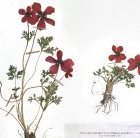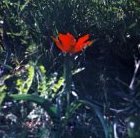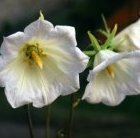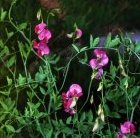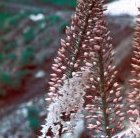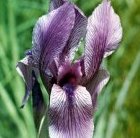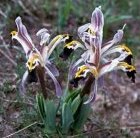 |
QUICK SEARCH
MO PROJECTS:
Africa
Asia/Pacific
Mesoamerica
North America
South America
General Taxonomy
Photo Essays
Training in Latin
America
MO RESEARCH:
Wm. L. Brown Center
Bryology
GIS
Graduate Studies
Research Experiences
for Undergraduates
Imaging Lab
Library
MBG Press
Publications
Climate Change
Catalog Fossil Plants
MO DATABASES:
W³MOST
Image Index
Rare Books
Angiosperm
Phylogeny
Res Botanica
All Databases
INFORMATION:
What's New?
People at MO
Visitor's Guide
Herbarium
Jobs & Fellowships
Symposium
Research Links
Site Map
Search
ORNAMENTAL PLANTS IN THEIR NATURAL HABITATSD. Tajikistan
The road from Dushanbe to the Anzob Pass runs along the river Varzob, the basin of which occupies the southern slope of the central Gissarskiy Range, and the flora and vegetation are typical of the
The submontane part of the Varzob gorge is characterized by broad-leaved forests and shrub formations, rich in roses. The sparse herbaceous cover includes small, dense cushions of the endemic Dionysia involucrata (primrose family) on cliffs, isolated patches of an inconspicuous bellflower Campanula incanescens as well as the skullcap Scutellaria hissarica and the showy sege Carex koshewnikowii. The field station and museum of the Botanical Institute of the Tajikistan Academy of Sciences is situated in the Kondara Gorge, which is ca. 10 km long (6 miles). The station is devoted to the study of the the forest vegetation of the Pamiro Alay. Mixed forests of common walnut Juglans regia, apple Malus sieversii and maple Acer turkestanicum grow in the bottom of the gorge. The herbaceous layer consists mainly of tall plants such as Ligularia thomsonii, Eremurus robustus, Delphinium ovczinnikovii and Cousinia pulchella, to mention a few. Scattered populations of a giant bellflower,
Cushions of Dionysia involucrata, the endemic Oxytropis
siomensis, and a number of other rock-loving species grow in the valley
of the Sioma river. The yellow Gymnospermium alberti [=Leontice alberti]
comes into flower in early spring, and a dark blue-flowered Asyneuma
Tall-herb semisavanna is present up to an altitude of 3,150 m (10,330 ft). The vegetational cover at the pass presents a conspicuous mosaic. The cushion-like red-flowered dwarf shrub Onobrychis echidna and the perennial thistles Cousinia franchetii and C. verticillaris are common in the area. Typical components of the steppes are bluegrasses (Poa relaxa and P. litvinoviana), cranesbills Geranium regelii and G. himalayense, anemones Anemonastrum protractum, edelweiss Leontopodium ochroleucum as well as a larkspur Delphinium oreophilum. Other species common to these areas include snow-in-summer or Dichodon cerastioides [=Cerastium cerastioides] and an elecampane Inula rhizocephala, which has a leafy rosette, practically no stem, but numerous white heads 3-4 cm (1.2-1.5") in diameter. Some of the more attractive species that grow on rocks at the upper limits of vegetation are Paraquilegia caespitosa, with flowers resembling those of the pasque flower; the mat-forming Draba cana [=D. lanceolata] and Allardia glabra [=Waldheimia glabra]. In early spring, southern Tajikistan is an ideal place to see many bulbous plants of the genera Crocus, Gagea, Iris, Juno, Rhinopetalum, Scilla, Tulipa, among others. In the eastern part of the Gissarskaya Valley occur showy species belonging to Papaver, Anemone and Scabiosa. Pistachio (Pistacia vera), which blooms in April, is evident near the Vakhsh River. Amygdalus bucharica [=Prunus] dominates the vegetational cover near the pass, where it grows along with such attractive herbs as Eremurus olgae, Delphinium semibarbatum, Onosma barsczewskii, Salvia sclarea and Scabiosa songarica. It should be noted that Kukhistan is of great interest to both botanists and gardeners. Here, botanists can find many endemic species, while horticultural enthusiasts can find many prospective plants for cultivation and breeding. Many potentially ornamental endemics are restricted to the Samarkand Mountains and the basin of the Mogian River. They include the attractive Acantholimon komarovii, Acanthophyllum saravschanicum, Eremostachys mogianica, Eremurus chloranthus, Juno magnifica [=Iris magnifica], J. maracandica [=Iris maracandica], J. parvula [=Iris parvula], Jurinea maxima, Scutellaria picta and Tulipa affinis. Many of them have been tested in botanical gardens in Central Asia, and they do well in cultivation; however, they are practically unknown in horticulture. |
||||||||
| ORNAMENTAL PLANTS FROM RUSSIA |
© 1995-2025 Missouri Botanical Garden, All Rights Reserved
4344 Shaw Blvd.
St. Louis, MO 63110
(314) 577-5100
Technical Support
